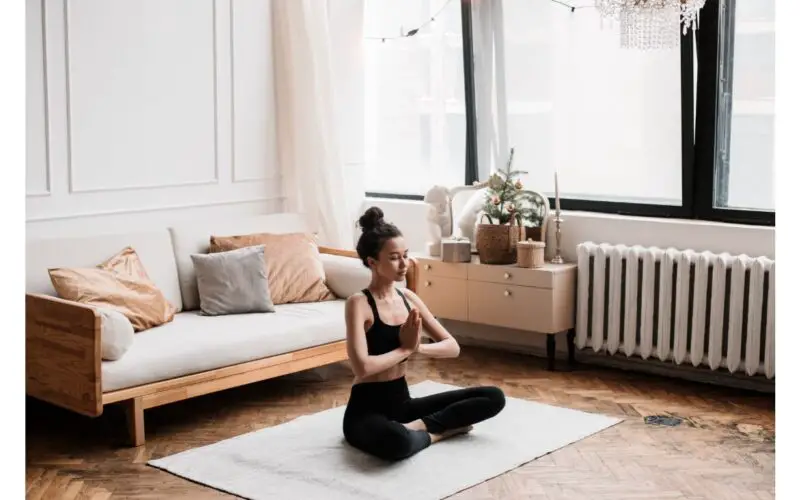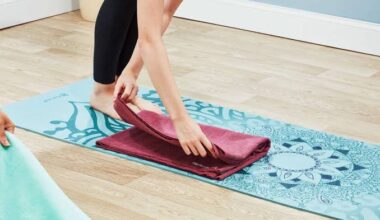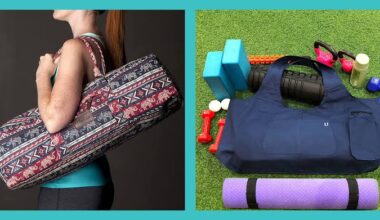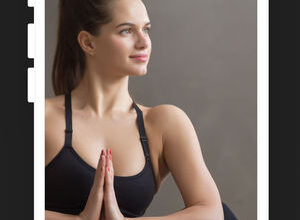Table of Contents Show
When it comes to practicing yoga, choosing the right surface to support your practice is essential. The debate about using a yoga mat vs yoga rug has been a hot topic among yogis for quite some time. Both options have their unique features and benefits, but which one is right for you? In this comprehensive guide, we will delve into the world of yoga mats and yoga rugs to help you make an informed decision. So, roll out your mat or rug, take a deep breath, and let’s get started!
Your Yoga Mat: More Than Just a Piece of Foam
Picture this: you step into a yoga studio, unfurl your yoga mat, and suddenly feel a sense of connection and stability beneath your feet. A yoga mat is like a trusty companion, providing a dedicated space for your practice. Made from durable materials such as PVC, rubber, or eco-friendly alternatives like natural rubber or cork, yoga mats offer a cushioned surface that enhances comfort and support during your poses. They come in various thicknesses, textures, and designs to suit different preferences and needs.
Disclosure: As an Amazon Associate I earn from qualifying purchases.
Finding Your Perfect Match: Choosing the Right Yoga Mat
Selecting the right yoga mat is akin to finding the perfect partner—it should complement your practice and meet your specific requirements. Here are a few factors to consider when choosing a yoga mat:
- Thickness: Are you looking for extra cushioning or a thinner, more grounded feel?
- Material: Do you prefer a traditional PVC mat or an eco-friendly option like natural rubber or cork?
- Texture: Are you inclined towards a sticky or non-slip surface to prevent slippage during sweaty sessions?
- Weight and portability: Will you be carrying your mat around frequently, necessitating a lightweight and easily transportable option?
- Durability: Do you need a mat that can withstand vigorous use and retain its shape over time?
The Grip Factor: Finding Stability on Your Mat
One of the primary concerns when practicing yoga is maintaining a secure grip. No one wants to slip out of a pose and end up in a comical heap on the floor! Yoga mats are designed with texture and grip in mind, allowing you to maintain stability during your practice. However, not all mats offer the same level of traction. High-quality mats with textured surfaces provide better grip, even in challenging poses or heated yoga classes where perspiration can make surfaces slippery. So, finding a mat that keeps you steady on your feet is crucial.
A Place for Your Mind: Enhancing Focus and Presence
Imagine trying to find inner peace and tranquility while practicing yoga on a cold, hard floor. Not the most ideal scenario, right? A yoga mat creates a dedicated space for your practice, both physically and mentally. When you unroll your mat, it becomes a sacred zone—a boundary that separates your practice from the outside world. It serves as a constant reminder to be present, enabling you to immerse yourself fully in the transformative experience of yoga. So, don’t underestimate the power of this humble piece of foam—it’s more than just a surface for your asanas!
Yoga Rugs: Embracing Tradition with Style
If you’re seeking a more traditional and authentic yoga experience, then a yoga rug might be just what you need. Yoga rugs have been used for centuries in India, where yoga originated. Made from natural fibers like cotton or wool, these rugs offer a firm and non-slip surface for your practice. Yoga rugs provide a unique connection to the ancient roots of yoga and are favored by practitioners who value tradition and simplicity.
Finding Harmony in Simplicity: The Appeal of Yoga Rugs
Yoga rugs embody simplicity in their design and function. Unlike yoga mats, which can vary in thickness and cushioning, yoga rugs offer a consistent and firm surface. They provide a stable foundation for your asanas, allowing you to feel grounded and connected to the earth beneath you. The natural fibers of yoga rugs also offer breathability, preventing excessive sweating and maintaining a comfortable temperature during your practice.
Customization and Creativity: Personalizing Your Yoga Rug
One of the standout features of yoga rugs is their versatility and the ability to personalize them. Unlike yoga mats, which often come in standardized designs and colors, yoga rugs can be customized to suit your preferences. You can choose from a variety of patterns, colors, and sizes, allowing you to express your creativity and make your practice space truly your own. This level of customization adds an element of joy and personal connection to your yoga journey.
A Test of Balance: Developing Stability on Yoga Rugs
Yoga rugs may not offer the same level of grip as yoga mats, but they provide an opportunity to enhance your balance and stability. The firm and slightly textured surface of a yoga rug challenge your body to engage more muscles to maintain equilibrium. As you progress in your practice, you’ll find that the balance and strength you develop on a yoga rug can translate to greater stability in other areas of your life.
Key Differences Between Yoga Mats and Yoga Rugs
Now that we’ve explored the unique features of both yoga mats and yoga rugs, let’s dive into the key differences between the two:
- Materials: Yoga mats are typically made from PVC, rubber, or eco-friendly alternatives like natural rubber or cork. Yoga rugs, on the other hand, are crafted from natural fibers such as cotton or wool.
- Texture and Grip: Yoga mats often have textured surfaces or patterns to enhance grip and prevent slippage. Yoga rugs provide a firm and slightly textured surface but may require a non-slip mat or grip pad underneath for stability.
- Cushioning and Thickness: Yoga mats come in various thicknesses, providing options for those who prefer extra cushioning or a more grounded feel. Yoga rugs offer a consistent and firm surface without the added cushioning.
- Portability: Yoga mats are lightweight and easily portable, making them ideal for those who travel or attend yoga classes outside their homes. Yoga rugs are bulkier and less portable, typically used in home practice or traditional settings.
- Customization: Yoga mats usually come in standardized designs and colors, whereas yoga rugs can be customized with patterns, colors, and sizes, allowing for a more personalized touch.
Considerations Before Making a Choice
Choosing between a yoga mat and a yoga rug ultimately comes down to personal preference and your specific needs. Here are a few factors to consider before making a decision:
- Practice Location: If you primarily practice at a yoga studio or attend classes, a yoga mat is likely the more practical choice due to its portability and convenience. However, if you have a dedicated practice space at home or prefer a more traditional yoga experience, a yoga rug can add a touch of authenticity and connection to your practice.
- Grip and Stability: If you engage in vigorous or heated yoga styles that involve a lot of movement or sweat, a yoga mat’s textured surface may offer better grip and stability. Yoga rugs, while providing a firm surface, may require an additional non-slip mat or grip pad to prevent slippage.
- Comfort and Cushioning: Consider how much cushioning and support you need during your practice. Yoga mats come in various thicknesses, allowing you to choose the level of cushioning that suits you. Yoga rugs offer a consistent and firm surface, which some practitioners prefer for a more grounded experience.
- Maintenance and Durability: Yoga mats are generally easier to clean and maintain, as they can be wiped down or even tossed in the washing machine. Yoga rugs may require more careful cleaning and may not be as durable as mats, particularly if they are made of natural fibers like cotton or wool.
- Aesthetic and Personalization: If you enjoy expressing your creativity and personalizing your practice space, a yoga rug provides more opportunities for customization. You can choose from a variety of patterns, colors, and sizes to make your practice area truly your own.
By considering these factors and your individual preferences, you can make an informed decision about whether a yoga mat or a yoga rug is the right choice for you.
Which Option is Best for Different Types of Yoga?
Now that we have explored the key differences between yoga mats and yoga rugs, let’s take a closer look at which option may be better suited for different types of yoga:
- Hatha Yoga and Gentle Practices: Hatha yoga classes typically involve slower-paced movements and focus on alignment and holding poses. For these practices, both yoga mats and yoga rugs can be suitable options. If you prefer a softer and cushioned surface, a yoga mat with medium thickness could be ideal. If you appreciate a firmer and more grounded feel, a yoga rug can provide the stability you need.
- Hot Yoga and Power Yoga: Hot yoga and power yoga classes are known for their intense physicality and profuse sweating. In these styles, where grip is essential to prevent slipping, a high-quality yoga mat with excellent traction is recommended. The textured surface of a mat can help maintain stability and prevent accidents during challenging poses.
- Ashtanga and Vinyasa Yoga: Ashtanga and vinyasa yoga styles are dynamic and often involve flowing sequences with continuous movement. For these practices, a yoga mat with good grip and cushioning is beneficial, as it allows for smooth transitions between poses and provides comfort during longer sequences.
- Restorative and Yin Yoga: Restorative and yin yoga classes focus on relaxation, stretching, and holding poses for extended periods. In these practices, where comfort and support are key, a thicker yoga mat or a yoga rug can offer the necessary cushioning and stability for longer holds and gentle stretching.
Ultimately, the choice between a yoga mat and a yoga rug for different types of yoga boils down to personal preference, comfort, and the specific demands of the practice.
Yoga Mat vs Yoga Rug: Pros and Cons
Let’s take a closer look at the pros and cons of both yoga mats and yoga rugs to help you make a well-informed decision:
Yoga Mat:
Pros:
- Portability: Yoga mats are lightweight and easy to roll up, making them highly portable. You can take your mat to the yoga studio, pack it for travel, or use it wherever you prefer.
- Grip and Traction: Yoga mats are designed with textured surfaces or patterns that provide excellent grip and traction, ensuring stability during poses, even in sweaty or challenging conditions.
- Cushioning: Yoga mats come in various thicknesses, allowing you to choose the level of cushioning that suits your comfort and support needs.
- Easy Maintenance: Mats are generally easy to clean and maintain. Many mats can be wiped down with a damp cloth, and some are even machine washable.
- Wide Variety: There is a wide range of yoga mat options available in terms of materials, thicknesses, textures, and designs, allowing you to find the perfect mat that suits your style and preferences.
Cons:
- Durability: While yoga mats are generally durable, they may wear out over time, especially with frequent and intense use. However, choosing a high-quality mat can significantly extend its lifespan.
- Environmental Impact: Traditional PVC mats are not environmentally friendly, as they are made from synthetic materials and are not biodegradable. However, there are now eco-friendly options available, such as natural rubber or cork mats, which minimize environmental impact.
- Chemical Odors: Some yoga mats, especially those made from PVC, may have a strong initial odor due to the manufacturing process. However, this odor usually dissipates over time with proper airing and use.
Yoga Rug:
Pros:
- Tradition and Authenticity: Yoga rugs have a rich history and are deeply rooted in the traditional practice of yoga. Using a yoga rug can create a sense of connection to the ancient origins of yoga.
- Firm and Stable Surface: Yoga rugs provide a firm and non-slip surface, allowing you to feel grounded and stable during your practice. They can help develop balance and strength.
- Breathability: Yoga rugs, typically made from natural fibers like cotton or wool, offer breathability, preventing excessive sweating and maintaining a comfortable temperature during your practice.
- Customization: Yoga rugs can be customized with various patterns, colors, and sizes, allowing you to personalize your practice space and add a touch of creativity to your yoga journey.
Cons:
- Bulkiness and Portability: Yoga rugs are bulkier and less portable compared to yoga mats. They are better suited for home practice or dedicated yoga spaces rather than being carried around to studios or while traveling.
- Grip and Stability: Yoga rugs may require an additional non-slip mat or grip pad underneath to prevent slippage, especially during intense or sweaty practices.
- Limited Cushioning: Unlike yoga mats, yoga rugs do not provide as much cushioning. If you require extra support or have sensitive joints, you may need to use additional props or blankets for added comfort.
It’s important to weigh these pros and cons based on your individual preferences, practice style, and requirements to make the right choice between a yoga mat and a yoga rug.
How to Care for Your Yoga Mat or Rug
To ensure the longevity and cleanliness of your yoga mat or rug, proper care and maintenance are essential. Here are some tips to keep them in excellent condition:
- Regular Cleaning: Clean your mat or rug regularly to remove sweat, dirt, and oils. Use a gentle yoga mat cleaner or a mixture of mild soap and water. For yoga rugs, check the care instructions provided by the manufacturer, as some may require hand washing or dry cleaning.
- Air Drying: After cleaning, allow your mat or rug to air dry completely before rolling or storing it. Avoid exposing them to direct sunlight for extended periods, as it may cause discolouration or damage.
- Storage: Roll up your yoga mat loosely with the top side facing outwards to prevent creases. Store it in a cool and dry place, away from direct sunlight and excessive heat. Yoga rugs can be folded and stored in a similar manner.
- Avoid Harsh Chemicals: Refrain from using harsh chemicals, bleach, or abrasive cleaners on your mat or rug, as they can damage the surface or fibers.
- Personal Hygiene: Maintain good personal hygiene by using a clean towel or practicing on a clean surface to minimize sweat and dirt buildup.
- Use with Care: Avoid dragging or sliding your mat or rug on rough surfaces, as it can cause wear and tear. Be mindful of sharp objects or jewelry that can puncture or damage the surface.
- Rotation and Replacement: If you practice regularly, consider rotating your mat or rug to distribute wear evenly. Over time, both mats and rugs will naturally wear out. Replace them when you notice significant signs of wear, such as thinning or fraying.
By following these care instructions, you can ensure the cleanliness, durability, and longevity of your yoga mat or rug, allowing you to enjoy a pleasant and hygienic yoga practice.
Conclusion
In the debate between yoga mats and yoga rugs, both options have their unique advantages and considerations. Yoga mats offer portability, grip, cushioning, and a wide variety of options to choose from. On the other hand, yoga rugs provide a connection to tradition, a firm surface, breathability, and customization.
When making your choice, consider factors such as your practice location, grip and stability requirements, comfort preferences, maintenance needs, and personalization options. Ultimately, the decision comes down to what resonates most with you and your yoga journey.
Remember, whether you choose a yoga mat or a yoga rug, what matters most is finding a practice surface that supports and enhances your yoga experience, allowing you to connect with yourself, your breath, and the present moment.
FAQs
Q1. Can I use a yoga rug on top of a yoga mat?
A: Absolutely! If you prefer the stability and connection to tradition that a yoga rug provides but still want the extra grip and cushioning of a yoga mat, you can place the yoga rug on top of the mat for the best of both worlds.
Q2. Are yoga rugs suitable for hot yoga or intense practices?
A: While yoga rugs can offer a firm and non-slip surface, they may not provide the same level of grip as yoga mats, especially in sweaty or intense practices. It’s advisable to use a non-slip mat or grip pad underneath the rug for added stability.
Q3. Can I wash my yoga rug in a washing machine?
A: It depends on the specific yoga rug and its care instructions. Some yoga rugs can be hand washed or gently machine washed, while others may require dry cleaning. Always refer to the manufacturer’s guidelines for the appropriate cleaning method.
Q4. Are yoga rugs eco-friendly?
A: Yoga rugs made from natural fibers like cotton or wool are generally considered more eco-friendly compared to synthetic materials used in some yoga mats. Natural fiber yoga rugs are biodegradable and have a lower environmental impact. However, it’s important to research and choose rugs made from sustainably sourced materials to minimize their ecological footprint.
Q5. Can I practice yoga without a mat or rug?
A: Yes, practicing yoga without a mat or rug is possible, especially if you have a non-slip floor or carpet. However, using a mat or rug provides additional cushioning, grip, and hygiene benefits. It also defines your personal space and creates a dedicated area for your practice. If you choose to practice without a mat or rug, make sure the surface is clean, comfortable, and provides adequate support.
Q6. Can I use a yoga mat or rug for other exercises?
A: Absolutely! Both yoga mats and yoga rugs can be versatile and used for various exercises beyond yoga. Mats provide cushioning and grip, making them suitable for Pilates, floor exercises, or general fitness routines. Yoga rugs, with their firm and stable surface, can also be used for meditation, stretching, or as a non-slip base for other activities.





Comments are closed.